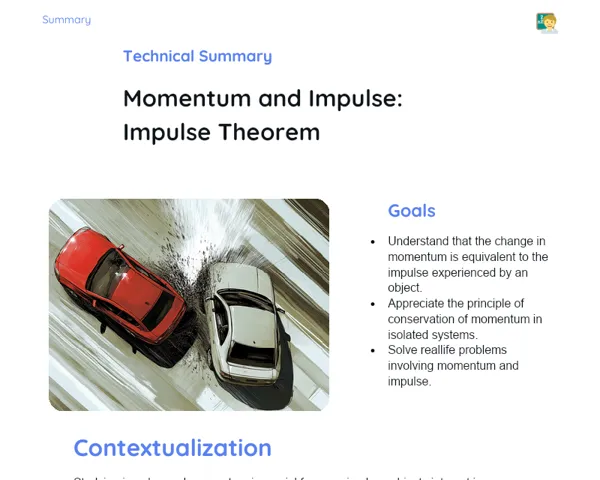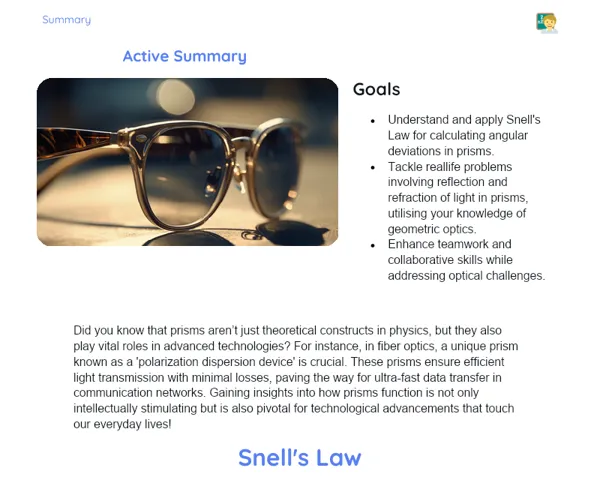Goals
1. Grasp that mechanical energy is conserved in simple harmonic motion.
2. Calculate the speed at various positions during simple harmonic motion.
3. Determine how much the spring deforms in a mass-spring system.
Contextualization
Simple Harmonic Motion (SHM) is a key concept in physics, representing periodic oscillations found in common examples like pendulums and springs. This phenomenon affects many aspects of our daily lives, from how clocks function to engineering buildings that can withstand earthquakes. Grasping SHM is crucial for advancements in technologies related to vibrations and waves, and it lays a solid foundation for higher studies in physics and engineering disciplines. SHM plays a vital role in the calibration of sensitive instruments like seismographs and in designing vehicle suspension systems.
Subject Relevance
To Remember!
Conservation of Mechanical Energy in Simple Harmonic Motion (SHM)
In Simple Harmonic Motion, the total mechanical energy remains constant. This indicates that the sum of kinetic energy (linked to motion) and potential energy (associated with position) does not change over time. When a mass is at its maximum displacement, all energy is potential, while at the equilibrium point, all energy transitions to kinetic.
-
The total mechanical energy comprises both kinetic and potential energy.
-
At maximum displacement, energy is entirely potential.
-
At the equilibrium point, energy is solely kinetic.
-
The conservation principle of mechanical energy is foundational in closed systems.
Kinetic Energy and Potential Energy in Mass-Spring Systems
In a mass-spring setup, kinetic energy is the energy due to the mass's movement. Elastic potential energy is what accumulates in the spring when it is deformed. Kinetic energy reaches its peak when the mass crosses the equilibrium point, while potential energy is highest at points where the spring is most compressed or extended.
-
Kinetic energy can be calculated using the formula: Ec = 1/2 mv², where m is mass and v is velocity.
-
Elastic potential energy is calculated as: Ep = 1/2 kx², with k being the spring constant and x the deformation.
-
The shift between kinetic and potential energy occurs during the mass's motion.
-
Understanding these energy dynamics helps us analyze the system's behavior and predict its motion.
Calculating Velocity and Spring Deformation
To find the mass's velocity at various points during SHM, we can apply the conservation of mechanical energy. Maximum speed occurs at the equilibrium position and is zero at the maximum displacement points. The spring's deformation is determined through the elastic force (Hooke's Law) and the stored potential energy.
-
Maximum velocity happens at the equilibrium point, marking peak kinetic energy.
-
At extreme positions, velocity is zero, and energy is fully potential.
-
Spring deformation can be found using: F = -kx, where F is the force and x is the deformation.
-
These calculations are crucial for anticipating the behaviors of oscillatory systems.
Practical Applications
-
Calibrating seismographs for accurate earthquake readings.
-
Developing vehicle suspension systems, enhancing comfort and safety.
-
Designing buildings that withstand earthquakes using concepts of SHM to manage and dissipate seismic forces.
Key Terms
-
Simple Harmonic Motion (SHM): A type of periodic oscillatory motion where the restoring force is proportional to the displacement.
-
Mechanical Energy: The total of kinetic and potential energy within a system.
-
Kinetic Energy: The energy pertaining to an object in motion, calculated as 1/2 mv².
-
Elastic Potential Energy: The energy contained in a stretched or compressed spring, computed using 1/2 kx².
-
Spring Constant (k): A measure of the rigidity of a spring, in units of N/m.
-
Spring Deformation (x): How far the spring deviates from its rest position.
Questions for Reflections
-
How is the conservation of mechanical energy in SHM evident in various real-life applications?
-
How can insights about kinetic and potential energy help tackle engineering challenges?
-
Why is comprehending SHM principles crucial for innovations in technologies involving vibrations and waves?
Practical Challenge: Exploring Mechanical Energy in a Mass-Spring System
In this challenge, you will create a mass-spring oscillator and examine the conservation of mechanical energy throughout its motion. You will compute the kinetic and potential energy at various points and verify energy conservation.
Instructions
-
Put together a mass-spring system using a spring and any mass you prefer.
-
Pull the mass downwards and release it, noticing the simple harmonic motion.
-
Use a stopwatch to measure the oscillation period and record your findings.
-
Calculate the kinetic and potential energy at selected points in the motion, applying the applicable formulas.
-
Confirm the conservation of mechanical energy during the motion, discussing your observations with classmates.



